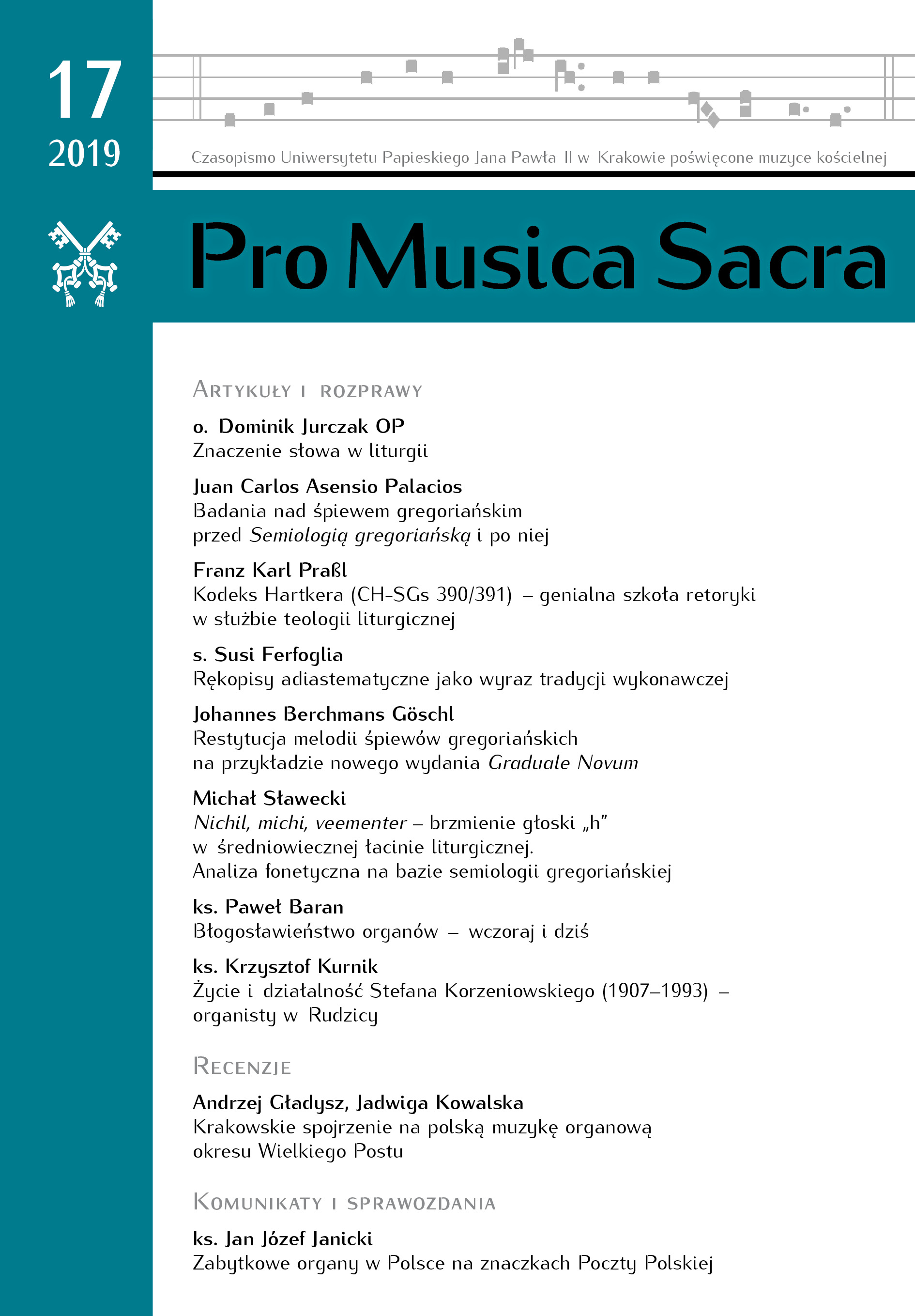The research on gregorian chant before and after the Cardine’s Semiology
DOI:
https://doi.org/10.15633/pms.3490Keywords:
gregorian chant XIX–XX century, restoration of chant, Solesmes Paleógraphie Musicale, Vatican edition, Gregorian SemiologyAbstract
The research on gregorian chant from the middle of the 19th century had their protagonists
mainly in some of the Solesmes monks, but not without polemics. After the
St. Pius X motu roprio, and the new Vatican edition, the Solesmes style and Methode…
was spread everywhere, but some voices, from the own monastery, claimed for a new
approach to the musical writing: the neumes. Dom Cardine’s Semiology was the science
created to answer some of the the lacks of the Mocquereau’s theories. In this paper I’ll
try to show a little history of the previous works to the Cardine’s Semiology, specially the
Cardine’s own works developed from the previous researches of the Paléographie musicale.
References
Bergeron K., Decadent Enchantments. The Revival of Gregorian Chant at Solesmes, Berkeley
Cardine E., L’édition critique du graduel. Nécessité, avantages, method, „Revue Grégorienne”
(1950) 29.
Cardine E., Signification de la désagrégation terminale, „Revue Grégorienne” (1952) 31,
s. 55–65.
Cardine E., Paroles et mélodie dans le chant grégorien, „Bollettino degli amici del PIMS”
(1954) 6/3, s. 1–9.
Cardine E., Neumes et rythme, w: Actes du 3e Congrés International de Musique Sacrée, (Paris,
juillet 1957), Paris 1959, s. 264–276.
Cardine E., Preuves graphiques du príncipe des “coupures” dans les neumes”, „Études Grégoriennes” (1961) 4, s. 43–54 et 6 planches.
Cardine E., Graduale neumé, Solesmes 1966.
Cardine E., Paleografia gregoriana, 1, Note raccolte dalle lezioni tenute da dom Eugène Cardine,Rome 1967.
Cardine E., Semiologia gregoriana, Rome 1968.
Cardine E., Primo anno di canto gregoriano, Rome 1970.
Cardine E., Les limites de la sémiologie en chant grégorien, „Études Grégoriennes” (1989) 23, s. 5–10.
Combe P., Histoire de la Restauration du Chant Grégorien d’après des Documents Inédits. Solesmes et l’Édition Vaticana Solesmes 1969.
Gontier A., Méthode raisonnée de plain-chant, Le Mans 1859.
González Barrionuevo H., Relación entre la notación mozárabe de tipo vertical y otras escrituras neumáticas, „Studi Gregoriani” (1995) 11, s. 5–112.
Graduale Triplex, Solesmes 1979.
Guéranger P., Institutions Liturgiques, vol. I, Paris–Bruxelles 1840.
Fonti e paleografia del canto ambrosiano, ed. M. Huglo, L. Agustoni, E. Cardine, E. Moneta-Caglio, Milano 1956 (Archivio Ambrosiano, 7).
Jeannin J., Études sur le rhytme grégorien, Lyon 1925.
Jeannin J., Rhytme Grégorien, Réponse à Dom Mocquereau, Lyon 1927.
Mocquereau A., Examen des critiques dirigéés par Dom Jeannin contre l’École de Solesmes, Solesmes 1926.
Paléographie musicale. Les Mélodies Liturgiques ou recueil de Fac-similés phototypiques des principaux manuscrits de chant grégorien, ambrosien, gallican, mozárabe, avec préface explicative publiée par les Révérends Pères Bénédictins de l’Abbaje de Solesmes, Solesmes 1888.
Pothier J., Les Mélodies Grégoriennes d’après la tradition, Solesmes 1880.
Pothier J., Liber Gradualis, Solesmes 1883.
Pothier J., Directorium Chori, Solesmes 1884.
Wagner P., Einfhrung in Die Gregorianischen Melodien, 3 vols. Leipzig 1911–1921.
Wollaerts J. A., Rhytmic Proportions in Early Medieval Eclesiastical Chant, Leiden 1956 (2ª ed. 1960).
Downloads
Published
Issue
Section
License
Authors who publish with this journal agree to the following terms:
- Authors retain the copyright and full publishing rights without restrictions, and grant the journal right of first publication with the work simultaneously licensed under a Creative Commons Attribution 4.0 International License that allows others to share the work with an acknowledgement of the work's authorship and initial publication in this journal.
- Authors are able to enter into separate, additional contractual arrangements for the non-exclusive distribution of the journal's published version of the work (e.g., post it to an institutional repository or publish it in a book), with an acknowledgement of its initial publication in this journal.
- Authors are permitted and encouraged to post their work online (e.g., in institutional repositories or on their website) prior to and during the submission process, as it can lead to productive exchanges, as well as earlier and greater citation of published work (See The Effect of Open Access).

